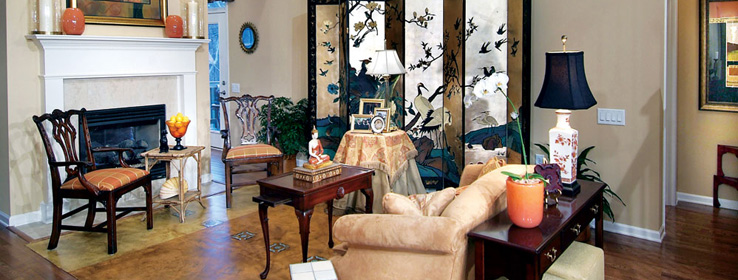Atlanta's Livable Lifetime Show House presents the new face of universal design.
Show houses, with their built-in "wow" factor, often elicit compliments from visitors. But none were more gratifying for designer Anna Marie Hendry, of Classic Interiors by Anna Marie, than the comments she heard at the Livable Lifetime Show House staged in suburban Atlanta earlier this year and sponsored by Sherwin-Williams. A first-of-its-kind showcase for universal design, the house drew a diverse crowd, including many people with physical disabilities.
She remembers one visitor, a young man in a wheelchair, who spent a long time on the upstairs balcony overlooking the living room Hendry had designed. Hendry was surprised at how easy it was to incorporate accessibility features without compromising design.
"[He] enjoyed the space for about an hour," she recalls. "At the end, he said, 'It's been years since I've been to the second story of anyone's home.'"
Making spaces accessible to all is the goal of universal design, a movement that is gaining momentum as baby boomers enter their retirement years hoping to "age in place" rather than be forced to enter nursing homes or assisted-living facilities.
"More than 80 percent of people over 50 want to live in their homes as long as possible, but most homes are built for able-bodied men," says Sandra McGowen, owner of McGowen Interiors and co-founder of the Universal Design Alliance, which presented the Livable Lifetime house. Building in universal design features is much less expensive than retrofitting them later, she notes.
The Livable Lifetime home was the first in the nation to marry universal design with professional interior design. "Most designer show houses are strictly for show," Hendry notes, while other examples of universal design have emphasized only accessibility features.
"Ours was unique in that we treated it just like a show house and used professional designers," McGowen says. "We wanted to show that universal design can be beautiful and functional, not institutional. We wanted to take away the 'handicapped' stigma. It's just good design, for everyone."
Surprising Ease
Hendry, who knew nothing about universal design before attending a seminar as part of the project, said she was surprised at how easy it was to incorporate accessibility features without compromising design. "No one coming in would have thought it was designed to accommodate people with disabilities," she says.
Universal design features in the home included an elevator and extra-wide doors and hallways to fit wheelchairs, as well as color-contrasting surfaces to aid the visually impaired; lamps controlled by touch; light switches placed lower on walls so that children and people in wheelchairs can reach them; electrical outlets placed higher to eliminate bending down; and a switch-controlled gas fireplace. Interior walls were painted with Sherwin-Williams Cashmere® Paint (Bagel SW 6114) in a flat enamel finish to minimize light reflection, which can be disorienting for people with impaired vision. Cashmere Interior Latex provides the smoothest finish possible, because it minimizes roller stipple.
For the living room, Hendry chose Chippendale-style furniture with high arms so that people with arthritis could easily push themselves out, and a folding screen to absorb sound – important for people who wear a hearing aid. Rounded corners on furniture and easily grasped drawer pulls also enhanced accessibility.
One of the room's focal points was a colorful floor cloth that Hendry painted herself. The cloth fulfilled the universal design mission of lying flat against the wood floor so it's not an obstacle for those using wheelchairs or walkers.
"I couldn't use a thick Oriental rug, but I could design something that fit the interior and gave it an Oriental appeal," Hendry says.
Similar universal design show houses are now being planned in other cities, McGowen says. "We would like to influence builders and consumers to ask for these features."






